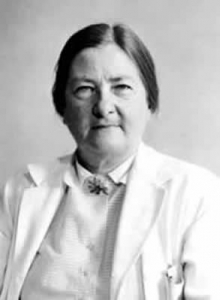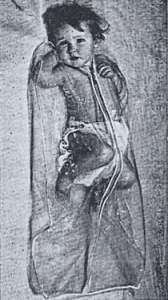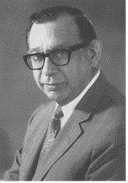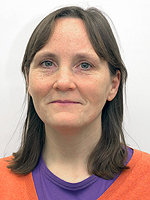The Sweat Test and Potential Difference Measurements
Undoubtedly the major advance during the Fifties was the recognition of the increased salt content of the sweat in people with CF by Paul di Sant’Agnese in 1953 (below). This followed the report of Kessler and Andersen in 1951 (below) of heat prostration in children with CF that occurred during a New York heat wave in August 1948. Subsequently the availability of the sweat test permitted an accurate diagnosis when CF was suspected and gradually replaced the more invasive duodenal intubation. Diagnosis by sweat analysis became more practicable, accurate, safe and more generally available when localised sweating was stimulated by the pilocarpine iontophoresis, as described by Gibson & Cooke, in 1959, (below) rather than by the various potentially dangerous methods of heating the whole patient to stimulate sweating. The availability of the sweat test permitted the recognition of people with CF who had adequate pancreatic function – so-called “pancreatic sufficient” individuals. Finally, it became apparent that if the test was carried out by inexperienced staff erroneous results, usually false positives, were not infrequent; eventually much attention was paid to ensuring that adequate standards were in place.
1951 Kessler WR, Andersen DH. Heat prostration in fibrocystic disease of the pancreas and other condition. Pediatrics 1951; 8:648.[PubMed]
One of the most important papers up to that time from New York. Walter Kessler, the senior resident at the time, and Dorothy Andersen reported 12

Dorothy Andersen
children with heat prostration. Ten were admitted during a New York heat wave in 1948 and no less than seven were known to have cystic fibrosis. These were the days before air conditioning was generally available in New York and 1948 was a particularly hot summer. Paul di Sant’Agnese was working with Dorothy Andersen at the time and looking after her patients, and later said that he treated these particular infants as Andersen was away vacationing in Europe when they were admitted! The authors of this present report queried whether the sweat glands, as well as the glands of the pancreas and other organs, were inadequate in function or alternatively whether a low grade infection lowered the margin of tolerance to increased temperatures.
At the time of this report there was no explanation as to why infants with CF were particularly susceptible to heat prostration and salt depletion – fortunately Paul di Sant’Agnese decided to find out! This was the first report that children with CF were particularly susceptible to heat. It was this original incident that eventually led Paul di Sant’Agnese to search for the reason for salt depletion in many of these CF infants and eventually to his recognising the abnormally high sweat sodium and chloride, and to a lesser extent potassium. This was undoubtedly the first and most important major advance in the understanding of the causation of CF up to that time (see di Sant’Agnese et al, 1953 below).
1953 Darling RC, di Sant’Agnese PA, Perera GA, Andersen DH. Electrolyte abnormalities of the sweat in fibrocystic disease of pancreas. Am J M Sc 1953; 225:67-70.[PubMed]

Bob Darling
The first report of elevated sweat electrolytes in cystic fibrosis. di Sant’Agnese collaborated with Bob Darling who was the head of the Rehabilitation Department of the Columbia Presbyterian Hospital. In this department there was a constant temperature room and a method of collecting sweat. Initially two teenagers with CF and two controls were selected and although the sweating rate was similar the level of electrolytes was much higher in the patients with cystic fibrosis. Subsequently sweat from nine CF children and eight controls showed chloride more than three times higher in the people with CF than in the controls. This was an unexpected finding quite unrelated to any previously recognised abnormalities in the condition (di Sant’Agnese et al, 1953 below) but it was the most important observation since the clear identification of CF as a specific entity by Dorothy Andersen in 1938.
1953 di Sant’Agnese PA, Darling RC, Perera GA, Shea E. Sweat electrolyte disturbances associated with childhood pancreatic disease. Am J Med 1953; 15:777-784.[PubMed]
In this study there were 50 patients with CF, 9 with other pancreatic diseases and 50 controls. All the CF patients had similar elevations in the sweat electrolytes. Their adrenal and renal function was normal. The authors considered the findings to justify abandoning the term “mucoviscidosis” and returning to the unsatisfactory term “cystic fibrosis of the pancreas” until a better one was proposed.
1953 di Sant’ Agnese PA, Darling RC, Perera GA, Shea E. Abnormal electrolyte composition of the sweat in cystic fibrosis: Clinical significance and relationship to the disease. Pediatrics 1953; 12: 549-563. [PubMed]

Paul di Sant’Agnese
This is the main paper that di Sant’Agnese himself quotes as describing the sweat electrolyte abnormality expanding on the paper of Darling et al, 1953 (above). Di Sant’Agnese mentions the original report of Kessler and Andersen 1951 (above) and also that the susceptibility of patients with CF to heat in the summers was noted also during subsequent summers after 1948. Paul Quinton more recently recalls that di Sant’Agnese told him that the development of heat tolerance among troops sent to North Africa was attributed to adaptations to sweating, so di Sant’Agnese pursued excessive salt loss in the sweat as the most likely origin of volume depletion during the high heat stress (Quinton, 1999 below). Bob Darling was head of Rehabilitation at Columbia Presbyterian Hospital and had a constant temperature room. Di Sant’Agnese decided “as a shot in the dark to see if sweating function was impaired in CF patients that would lead to a smaller than normal volume of sweat, or whether there was something wrong with the sweat electrolyte concentration”. di Sant’Agnese continued – “In April 1952 two teenage children with CF and two controls were put in the constant temperature room and their sweat then analysed for electrolytes. To my surprise and excitement the answer was right there. There was a tremendous difference in the sweat electrolyte concentration between the two groups”. “In contrast the sweating rate was similar in the two groups”. (Described in detail by Paul di Sant’Agnese. Experiences of a Pioneer Researcher. In: Doershuk CF (ed.) Cystic Fibrosis in the 20th Century 2001; Fanos JH. 2008; 17-35.). Sant’Agnese and colleagues showed the sweat abnormality was unrelated to renal or adrenal disease and was definitely related to sweat losses.-
For this present paper they examined 43 people with CF, nine patients with other pancreatic diseases and 50 controls in a room at 32.2 C for one to two hours. Sweat was collected onto dry gauze under adhesive waterproof plaster. Sweat chloride in the CF patients was 106 (60-160) meq/l, in controls and other pancreatic diseases only 32 meq/l (4-80) and in CF the Na 133 (80-190), and in controls 59 (10-120).
– This was undoubtedly the most important advance in the understanding of CF up to that time. However, astonishingly, di Sant’Agnese recalls the paper received a very cool reception at the 1953 meeting of the American Pediatric Society with not a single question! Also when presented before Jas Kuno, apparently a distinguished sweat physiologist, Kuno uttered one word -“impossible”- and walked out of the room! It is also said that even di Sant’ Agnes’s close colleague Dorothy Andersen was at first reluctant to accept the findings. However, and perhaps predictably, Harry Shwachman soon visited di Sant’Agnese in New York; he was impressed and with his usual alacrity and energy was able to present a large supportive series by October 1954 much to di Sant’Agnese’s delight!
1956 Webb BW, Flute PT, Smith MJH. The electrolyte content of the sweat in fibrocystic disease of the pancreas. Arch Dis Child 1957; 32:82-84. [PubMed]
An early UK study from the Departments of Chemical Pathology and Paediatrics, Kings College Hospital, London – the first UK study since di Sant’

Child is plastic bag for sweat collection
Agnese’s description of the sweat abnormality (di Sant’ Agnese et al, 1953 above). Twelve patients with CF, aged between 11 months and six years, and 20 controls had sweat electrolytes estimated which confirmed the findings of di Sant’Agnese et al, 1953. Controls had sweat sodium of 27 (4-32) meq/l and chloride of 23 (9-40) meq/l and the CF children sodium values of 125 (72-157) and chloride values of 127 (68-148) meq/l.
The patient was “placed in a plastic bag tied loosely around the neck (figure 1) and allowed to lie in a cot or bed covered with three or four blankets. The sweat was collected on weighed filter papers which were applied to the back (figure 2). “In some instances the children were restive at first but quickly became used to the conditions”.
Subsequently there were a number of complications with this method of sweat testing in some hospitals, as a result of over-heating small debilitated CF infants in this manner, including one fatality (Misch & Holden, 1958 below).
1956 Shwachman H, Gahm N. Studies in cystic fibrosis. Simple test for detection of excessive chloride on the skin. N Eng J Med 1956; 255:999-1001. [PubMed]
Due to the high level of chloride in the sweat, people with CF produce white fingerprints on plates impregnated with silver

Harry Shwachman.
nitrate and potassium chromate (figures 3 ). Dr Kulczycki (long time colleague of Harry Shwachman’s) performed 1443 control tests at an in4stitution for the mentally handicapped.
The authors suggested “the plate test” as a screening test for CF but it never became popular. When the sweat test became more readily available in the early Sixties following the publication of Gibson and Cooke (1959 below), the result was so important that it was preferred to the semi-quantitative plate test.

Lucas Kulczycki
Subsequently Lucas Kulczycki (Am J Dis Child 1960; 100:174-180) screened 3036 school children with the plate test. There were 2% false positives on first test and no children with CF were identified. Authors suggested it would be better to use the test in well-baby clinics.
Although the total heating of the child to induce sweating was obviously causing serious problems at times, the Gibson & Cooke iontophoresis method was soon to be reported in 1959. Subsequent screening tests using chloride electrodes, paper strips, salivary electrolytes, meconium albumin and faecal trypsin have all been relative failures with the exception of blood immunoreactive trypsin in neonates which has become internationally accepted as the basis of neonatal screening programmes (Crossley et al, 1979 above).
1956 Johnston W H. Salivary electrolytes in fibrocystic disease of the pancreas. Arch Dis Child 1956; 31: 477-480.[PubMed]
A study from Great Ormond Street Hospital in London showing elevated sodium and chloride in the stimulated saliva of 31 patients with CF compared with 63 controls. The separation was not such that the test had diagnostic value and also the values depended on the rate of flow.
Prader & Gautier (Helv Paediat Acta 1955; 10:56) had found the saliva sodium was increased in cystic fibrosis. Unfortunately these various studies the electrolyte content CF saliva did not prove helpful in either the diagnosis or the understanding of the nature of the CF basic defect (also Lawson et al. 1956. below).
The studies were an natural follow-on from the recently described sweat electrolyte abnormalites – estimation of the electrolyte content of the finger nails was still to come (Kopito et al, 1965 below)!
1957 MacFarlane JCW, Norman AP, Stroud CE. Fingerprint sweat test in fibrocystic disease of the pancreas. BMJ 1957; (5039):274-275.[PubMed]
The finger print test, devised by Shwachman & Gahm, 1956, (above) was tried in view of the difficulties, and even dangers, of collecting sweat by

Archie Norman
heating the whole patient, in the years before the Gibson and Cooke iontophoresis method was described in 1959. In fact, children were known to have died due to overheating in an attempt to obtain sweat (Misch & Holden, 1958 below).
The 54 children with CF in this study were all strongly positive with the finger print test. The authors suggested the test was useful and safe – but they considered it needed further evaluation. However, within 2 years the pilocarpine iontophoresis method of sweat stimulation of Gibson and Cooke (1959 below) would be described and this would become the standard method of sweat stimulation at the Hospital for Sick Children, London – although considerably more time-consuming and also open to serious errors if performed by an inexperienced operator as was later documented (Smalley et al, 1978 below).
Subsequently a study confirming the value of the Gibson and Cooke test was performed at the Great Ormond Street Hospital by Tom McKendrick, a Senior Registrar there at the time (McKendrick, 1962 below).
1958 Misch KA, Holden HM. Sweat test for diagnosis of fibrocystic disease of the pancreas. Arch Dis Child 1958; 33:179-180. [PubMed]
Fatal collapse of a patient having “Shwachman sweat test” (see figure above in Webb et al, 1956) which involved the whole body being enclosed in a plastic bag as a method of heating the patient to obtain an adequate sample of sweat. This boy aged 13 months was heated for 3 hours and developed hyperpyrexia, vomited copiously, became comatose and he died after 14 hours.
Shwachman commented that in his unit 1900 tests had been performed by the bag method with only one serious untoward reaction of hyperpyrexia and convulsions – the patient recovered and did not have cystic fibrosis.
In the UK there were a number of serious reactions which never appeared in journals, before the Gibson & Cooke pilocarpine method of inducing sweating was described in 1959.
1959 Gibson LE, Cooke RE. A test for concentration of electrolytes in sweat in cystic fibrosis of the pancreas utilising pilocarpine electrophoresis. Pediatrics 1959; 23:545-549.[PubMed]

Robert Cooke
This classic paper described the pilocarpine iontophoresis method for stimulating sweating to obtain sweat for analysis. It was a major advance, as prior to this these frail infants were often heated in blankets or plastic bags. The pilocarpine iontophoresis method is still used by most laboratories for stimulating localised sweating.
(See main text for more information on Lewis Gibson and Robert Cooke).
Subsequently, as more laboratories performed the test caution was expressed as when performed by inexperienced operators mistakes occurred. These mistakes often resulted in CF being over diagnosed when the sweat result was falsely high which could happen if the sweat specimen was allowed to evaporate. Also, there were reports of burns under the electrodes. The first report of such major diagnostic errors in the UK was from Birmingham (Smalley et al, Lancet 1978; ii: 415-417 below) from Prof. Charlotte Anderson’s unit but soon others followed (David TJ & Phillips BM. Lancet 1982; ii: 1204-1205.[PubMed]).
In Leeds we found that 7 (4%) of the first 179 children referred for Comprehensive Assessment of their CF from various parts of the UK did not have the condition (Shaw NJ & Littlewood JM. Arch Dis Child 1987; 62:1271-1273.[PubMed]). The consequences of a false diagnosis of CF frequently had disastrous socio-medical consequences e.g. one mother had been sterilised to avoid another child with CF as it was mistakenly thought her first child had CF. Many parents had avoided having further children; some parents took legal action against the paediatrician involved in the mistaken diagnosis.
So the sweat test is an excellent test if carried out correctly by experienced laboratory staff but can be disastrous if performed by inexperienced staff as an occasional procedure and the result accepted uncritically by the paediatrician and considered with all the other clinical and laboratory evidence when making a diagnosis of cystic fibrosis.
1959 Marie J, Salet J, Debris P, Hebert S, Corbin JL, Bezri A. Edematous form of cystic fibrosis of pancreas with hypoproteinaemia and anaemia (French). Sem Hop Paris 1959; 35:2140-6.
A report of the oedema and hypoproteinaemia in an infant with CF (also Lee PA et al, 1974; Gunn T et al, 1978 below). Also infants with CF presenting in this manner may have a false negative sweat test (Maclean WC, Tripp RW. J Pediatr 1973; 83:86-88. [PubMed]).
1960 Anderson CM, Freeman M. Sweat test results in normal persons of different ages compared with families with fibrocystic disease of the pancreas. Arch Dis Child 1960; 35: 581-587.[PubMed]

Charlotte Anderson
Charlotte Anderson (from Melbourne and later Birmingham UK) showed no abnormality in the sweat electrolytes from parents or siblings of people with CF nor in patients with other chronic chest diseases. A wide scatter of results was obtained in adults for example 34/100 normal adults had sweat sodium levels over 60meq/l. Anderson states that “determination of sweat sodium and chloride loses much of its value” in adults. Also intradermal mecholyl chloride was used to stimulate sweating in Anderson’s study.
This method of stimulating sweating did not become popular and we heard of one serious reaction with the method. The details of the methods used in the study were criticised by di Sant’Agnese as a different dose of mecholyl was used in the different age groups and this may have affected the rate of sweating which would influence the concentration of electrolytes (also Simmonds EJ, et al. Arch Dis Child 1989; 64:1717-1720. [PubMed] ). di Sant’Agnese considered that the conclusions drawn by Anderson and Freeman “were not warranted by their limited experience”. Fortunately during the Sixties the sweat test by the Gibson and Cooke pilocarpine iontophoresis method, first described in 1959 (above), slowly became the gold standard. Later studies from Great Ormond Street, London (McKendrick et al, 1963 below) showed the sweat electrolytes were insignificantly higher than normal in obligatory heterozygotes.
1961 Shwachman H, Antonowicz I, Stern M. The sweat tests in cystic fibrosis. Am J Dis Child 1961; 102:769.
An interesting report where Shwachman describes performance of over 2000 “bag” sweat tests – 335 in patients with CF. The mean chloride level in CF was 113 meq/L and mean sodium 112meq/L compared with controls’ values of 23 and 23 respectively. The bag method was abandoned in 1958 in preference to the pilocarpine method of Gibson and Cooke (1959 above) with which the bag results were compared.
1961 Elian E, Shwachman H, Hendren WH. Intestinal obstruction in the newborn infant; usefulness of the sweat electrolyte testing differential diagnosis. N Eng J Med 1961; 264:13-16.[PubMed]
The authors managed to perform pilocarpine iontophoresis sweat tests in the first four days of life in 37 babies- a difficult feat at this early age. Another six newborns with intestinal obstruction were tested – the four with CF were all sweat test positive and the two with negative sweat tests had respectively Hirschprung’s disease and ileal atresia.
So sweat tests were already positive in the newborn period in infants with CF but an experienced and skilful technician would be required to perform the investigation. If an urgent answer is required at the present time a check on the infant for the presence of CF mutations would be helpful in most instances.
1962 McKendrick T. Sweat sodium levels in normal subjects, in fibrocystic patients and their relatives and in chronic bronchitis patients. Lancet 1962; I: 183-186.
A study by Dr Tom McKendrick, a senior registrar working at Great Ormond Street, London with Dr (now Dame) Barbara Clayton, the chemical pathologist, and Dr Archie Norman, using the recently described Gibson and Cooke pilocarpine iontophoresis method of sweat stimulation (Gibson & Cooke, 1959 above). In normal children sweat sodium was almost always less than 60 meq/l rising from 22 to 44 in the first 14 years and rising to 55 in adults. 95% of people with CF had sodium levels over 70 and parents and siblings showed levels slightly greater than normals. The levels were normal in chronic bronchitis patients i.e. there were no people with CF amongst those considered to have chronic bronchitis.
The conclusion was that the “The wide variation of results both in single subjects and within groups of similar subjects limit the value of the test. It is useful only for confirming the diagnosis of cystic fibrosis” – for which, of course, it proved of immense value and to be a major advance, eventually becoming the “gold standard” method of sweat testing.
1962 Shwachman H. The sweat test. Pediatrics 1962; 30:167-171. [PubMed]
A commentary on the relatively recently described sweat test by Harry Shwachman and the article is full of wise advice. While the sweat test is specific for CF the following factors were crucially important in diagnosis. Maintaining a high degree of suspicion noting the great variability of the disease; the presence of elevated electrolytes alone does not establish the diagnosis; many factors influence the result – not least the experience of the laboratory; diagnosis should not be made lightly but only after careful appraisal of the patient, the family history and laboratory evidence. Heterozygotes cannot be detected with the sweat test.
One suspects that over diagnosis was a relatively common problem in Shwachman’s experience due false high values of sweat electrolytes – this article discusses some of the confounding and other factors that affect the test. A key publication from Charlotte Anderson’s unit in the UK documented the frequent over diagnosis of the condition in the UK (Smalley et al, 1978 below) and was of great importance in alerting UK paediatricians to the problem.
1963 Lobeck CC, McSherry NR. Response of sweat electrolyte concentrations to 9 alpha-fluorohydrocortisone in patients with cystic fibrosis and their families. J Pediatr 1963; 62: 393-398. [PubMed]

Charles Lobeck
Patients with CF failed to show a significant decrease in their sweat electrolytes after administration of oral 9-alpha fluorohydrocortisone (3.0 mg per square meter for two days). Parents, siblings of people with CF and controls all had a significant decrease in the concentration of their sweat electrolytes after this challenge – for example the fall in chloride in parents was – 40.8%, in controls – 43.6%, in siblings -35.6%, but people with CF only had -1.1% reduction in their sweat chloride level.
This was a practically useful paper when there was a problem with diagnosis and there was a marginal sweat test result – particularly pre-1989 before genetic mutations could be determined. We used the test on a number of occasions and found it to be helpful when the diagnosis was in doubt and the sweat test result borderline with chloride values of around 50 – 70 meq/l. Margaret Hodson at the Brompton Hospital in London also found the fludrocortisone suppression test useful in adults with marginal sweat test results (Hodson ME et al. BMJ 1983; 286:1381-1383.[PubMed]).
1968 Schwarz V, Sutcliffe CH, Style PP. Some hazards of the sweat test. Arch Dis Child 1968; 43:695-701. [PubMed]
A detailed paper dealing with many practical aspects of the sweat test. Burns and blisters at the site of the electrodes were shown to be caused by penetration of acid generated electrolytically to the vicinity of the patient’s skin. Prevention of these and other errors are discussed in detail. In particular, the rapid evaporation which can occur from the collection pad resulting in up to a twofold increase in concentration of the sweat in 30 seconds – probably this is the major cause of over diagnosis from false high results.
For some years after the Fifties sweat tests were performed in many small laboratories on an occasional basis and mistakes were made – these were usually false positives and were due to evaporation leading to false high sweat electrolyte values (Smalley et al, 1978 below).
1972 Elliott RB. The effect of essential fatty acid on sweat sodium concentrations in cystic fibrosis. Aust Paediatr J 1972; 8:217

Bob Elliot
Prof. Bob Elliott and colleagues from Auckland, New Zealand published several papers showing improvement in the clinical state when children with CF were supplemented with medium chain triglycerides even to the extent of returning the sweat electrolytes to nearer normal values (also Elliott RB, Robinson PG. Arch Dis Child 1975; 50:75-78 below; Elliott RB. Pediatrics 1976; 57:474-479 below).
There was considerable discussion as to whether a disturbance of fatty acids resulted in an abnormality of prostaglandins. Rivers JA & Hassam AG suggested an abnormality of fatty acid metabolism such that there was a need for increased linoleic acid (Lancet 1975; ii: 642-643.[PubMed]). Subsequent studies failed to substantiate their findings (Davidson GP et al. Aust Paediatr J 1978; 14:80-82.[PubMed]; Chase et al. Pediatrics 1979; 64:207-213.[PubMed]).
1973 MacLean WC, Tripp RW. Cystic fibrosis with oedema and falsely negative sweat test. J Pediatr 1973; 83:86-88. [PubMed]
An infant with CF, fed soya milk from age of 3 weeks, had oedema from 4 weeks. The sweat Cl values were 15 and 18 meq/l; later these had risen to 73 and 88 meq/l respectively. Subsequent reports of screened CF infants on normal milk feeds showed that, even in healthy CF infants, sweat tests may be relatively low and certainly less than 60 meq/l. (Massie J et al. Pediatr Pulmonol 2000; 29:452-456. below). So values over 30 meq/l would eventually be regarded as abnormal or requiring further investigation for a young infant. Also Lee PA, Roloff DW, Howatt WF. Hypoproteinemia and anaemia in infants with cystic fibrosis: Presenting symptom complex often misdiagnosed. JAMA 1974; 228: 585-588.[PubMed].
Fifty one such infants are already described in literature. One third died and 14 had received soya milk feeds.
1975 Sarsfield JK, Davies JM. Negative sweat tests and cystic fibrosis. Arch Dis Child 1975;50:463-466. [PubMed]

John Davies

Jim Sarsfield
This was the first publication on CF from our general paediatric unit at Seacroft Hospital, Leeds where I had enlisted the out patient sister (senior nurse), dietitian and physiotherapist to join me in a small monthly CF clinic in 1975; there was an increasing interest in CF at the hospital. Dr John Davies, our senior paediatric registrar at the time, had developed stimulated pancreatic function tests on the lines recommended by Hadorn et al (1968 above), and reliable sweat tests had been available since the mid-Sixties performed by Mr. Alan Steele the biochemist; the latter service was used by many of the paediatricians in the Yorkshire Region since the mid-Sixties. This report is of two brothers with chronic suppurative pulmonary disease; one had classical CF with complete pancreatic involvement and abnormal sweat tests. The other had incomplete pancreatic disease and repeatedly normal sweat tests. With these findings it was concluded that ”undue reliance on the sweat tests, especially when used for exclusion of cystic fibrosis, may be misplaced”. The two authors eventually became consultant paediatricians – Jim Sarsfield in Harrogate and John Davies in Grimsby.
Subsequently there have been many reports of patients with CF who had normal sweat tests some of whom have had unusual so-called “mild” mutations. Also, a more recent review of sweat tests in infants with CF diagnosed by neonatal screening, has shown that some infants with CF do indeed have a sweat test within the normal range for some time (Massie J et al. Pediatr Pulmonol 2000; 29:452-456.[PubMed]).
1978 Smalley CA, Addy DP, Anderson CM. Does that child really have cystic fibrosis? Lancet 1978; ii: 415-417. [PubMed]
The first report from a major paediatric centre of children mistakenly diagnosed and treated as having cystic fibrosis. In this report, from Prof. Charlotte Anderson’s Birmingham CF unit, 14 referred children had an incorrect diagnosis of CF – 13 had previous sweat tests in other laboratories “where test not done very often”. In 5, detailed pancreatic function testing was normal. None had chest disease and only 2 had any gastrointestinal symptoms. The authors advised that “in the absence of typical clinical features of the disease, a diagnosis of cystic fibrosis should be made with extreme caution”.
– This was a very important paper and prompted a number of reports on mistaken diagnosis (David TJ, Phillips BM. Over diagnosis of cystic fibrosis. Lancet 1982; 2:1204-1206.[PubMed]).
The first 179 children, already diagnosed and treated as CF in general paediatric departments, who were referred to our Leeds CF Centre for Comprehensive Assessment during the Eighties, no less than 7 (4%) were found not to have CF – a sweat test to check the diagnosis was part of our assessment for which they were referred (Shaw NJ, Littlewood JM. Arch Dis Child 1987; 62:1271-1273 below). The over-diagnosis was usually the result of an uncritical acceptance of a positive sweat test result performed in a laboratory where the test was only performed occasionally.
1981 Webster Hl, Barlow WK. New approach to cystic fibrosis diagnosis by use of an improved sweat-induction/collection system and osmometry. Clin Chem 1981; 27:385-387.[PubMed]
First use of osmometry of the sweat to distinguish people with CF from controls. The method was validated in a number of subsequent studies (Kirk JM et al. 1983 below) but never became widely adopted or replaced the standard sweat test.
First use of osmometry of the sweat to distinguish people with CF from controls. The method was validated in a number of subsequent studies (Kirk JM et al. 1983 below) but never became widely adopted or replaced the standard sweat test..
1983 Kirk JM, Adams A, Westwood A, McCrae WM. Measurement of osmolality and sodium concentration in heated cup sweat collections for investigation of cystic fibrosis. Ann Clin Biochem 1983; 20:369-373. [PubMed]
A study from Edinburgh of a new system (Wescor) for sweat collection and analysis with respect to its suitability for the investigation of children suspected to have cystic fibrosis. The effects of iontophoresis current sweat collection time, sweat storage and analysis were examined, and as a result the technique was modified to allow collection and storage of sufficient sweat for sodium and potassium as well as osmolality assays in 10-20 minutes. The small electrodes and speed of the procedure made it practical for use with small children, with a reproducibility of 13-24% (coefficient of variation for whole procedure (also Carter EP et al. 1984; Webster & Barlow, 1981). Most centres did not employ this system.
2000 Massie J, Gaskin K, Van Asperen P, Wilcken B. Sweat testing following newborn screening for cystic fibrosis. Pediatr Pulmonol 2000; 29:452-456. [PubMed]

John Massie
Thirty-nine of 85 DeltaF508 homozygous and 270 of 274 DeltaF508 heterozygous infants had sweat tests reported to the screening program. There were 6 DeltaF508 heterozygous infants with sweat chloride concentrations of 40-60 mmol/L and subsequently 4 of the 6 had CF confirmed. Infants with sweat chloride levels of 40-60 mmol/l require further investigation and review, but they almost certainly have CF.
The chloride/sodium ratio previously recommended in evaluating marginal sweat test results (Green A, et al. Ann Clin Biochem 1985; 22:171-174. [PubMed]; Henderson MJ, et al. Ann Clin Biochem 1986; 23:109 [PubMed];) was not useful in establishing a diagnosis of CF in these infants.
This paper is helpful and important confirmation that sweat chloride results can be well below the traditional level of 60 meq/l for a positive diagnosis in young infants with CF. In a later study of young non-CF infants the sweat chloride was inversely related to age at testing. For example, chloride values for infants aged between 3-7 days were only 23.3 +/-5.7 mmol/l, 8-14 days 17.6 +/-5.6 mmol/l, 15 – 42 days 14.8 +/- 5.9 mmol/l, and more than 42 days 13.1 +/- 7.4mmol/l (Eng W et al. Pediatr Pulmonol 2005; 40:64-67. [PubMed]
Professor John Massie trained in Sydney (from where this paper originated) and is now head of Education and Training at the Royal Children’s Hospital, Melbourne.
2007 LeGrys VA, Yankaskas JR, Quittell LM, Marshall BC, Mogayzel PJ Jr. Cystic Fibrosis Foundation. Diagnostic sweat testing: the Cystic Fibrosis Foundation guidelines. J Pediatr 2007; 151:85-89. [PubMed]
The recent guidelines from the CF Foundation. Similar guidelines have been published in the UK (Report from the Multi-Disciplinary Working Group. Anne Green Nov. 2003) and other countries so important is it that sweat tests are accurate to avoid the clinical disasters of mistaken diagnoses. Usually the mistakes are over-diagnosis due to the uncritical acceptance by the clinician of an false high sweat test.
2007 Green A. Kirk J. Guidelines Development Group. Guidelines for the performance of the sweat test for the diagnosis of cystic fibrosis. Ann Clin Biochem 2007; 44(Pt 1):25-34.[PubMed].
A multidisciplinary group (representing various professional bodies and supported by the Cystic Fibrosis Trust) has developed evidence-based guidelines for the performance of the sweat test in the UK. The guidelines cover patient information, subject suitability, sweat collection, sweat analysis, quality, interpretation of results, and responsibility for testing and training. The guidelines were produced following a detailed literature search by the process described by the Royal College of Paediatrics and Child Health (RCPCH), using the Scottish Intercollegiate Guidelines Network 1 (SIGN 1) criteria to grade the evidence. Recommendations are graded A, B, or C, depending on the level of evidence. The grade B recommendations (there were no grade A recommendations) were subsequently appraised and endorsed as part of the RCPCH process, according to Appraisal of Guidelines for Research and Evaluation in Europe (AGREE). The recommendations are summarized in tabular form representing the final version incorporating the comments from the appraisal process.
Both the appraisal comments and the full evidence base can be found on www.rcpch.ac.uk/publications/clinical_docs.html. The full guidelines can also be found on http://www.ukneqas.org.uk/guidelines.htm.
2008 Desax MC, Ammann RA, Hammer J, Schoeni MH, Barben J. Swiss Paediatric Respiratory Research Group. Nanoduct sweat testing for rapid diagnosis in newborns, infants and children with cystic fibrosis. Eur J Pediatr 2008; 167:299-304.[PubMed]
Determination of chloride concentration in sweat is the current diagnostic gold standard for CF. Nanoduct is a new analyzing system measuring conductivity which requires only 3 microliters of sweat and gives results within 30 minutes. The authors concluded that the Nanoduct test is a reliable diagnostic tool for CF diagnosis: It has a failure rate comparable to other sweat tests and can be used as a simple bedside test for fast and reliable exclusion, diagnosis or suspicion of CF. In cases with borderline conductivity (60-80 mmol/L) other additional methods (determination of chloride and genotyping) are indicated.
2009 Goubau C, Wilschanski M, Skalicka V, Lebecque P, Southern KW, Sermet I, Munck A, Derichs N, Middleton PG, Hjelte L, Padoan R, Vasar M, De Boeck K. Phenotypic characterisation of patients with intermediate sweat chloride values: towards validation of the European diagnostic algorithm for cystic fibrosis. Thorax 2009; 64:683-691. [PubMed]Patients with intermediate sweat chloride values in whom either additional CF diagnostic test was abnormal were compared with subjects in whom this was not the case and patients with classic CF. The phenotypic features of four groups were compared: 59 patients with CFTR dysfunction, 46 with an intermediate sweat chloride concentration but no evidence of CFTR dysfunction (CF unlikely), 103 patients with CF and pancreatic sufficiency (CF-PS) and 62 with CF and pancreatic insufficiency (CF-PI). The CFTR dysfunction group had more lower respiratory tract infections (p = 0.01), more isolation of CF pathogens (p<0.001) and clubbing (p = 0.001) than the CF unlikely group, but less frequent respiratory tract infections with CF pathogens than the CF-PS group (p = 0.05). Patients in the CF-PS group had a milder phenotype than those with PI. Many features showed stepwise changes through the patient groups.
The authors concluded that patients with intermediate sweat chloride values and two CFTR mutations or an abnormal NPD measurement have a CF-like phenotype compatible with CFTR dysfunction and, as a group, differ phenotypically from patients with intermediate sweat chloride values in whom further CF diagnostic tests are normal as well as from CF-PS and CF-PI patients.
Although these conclusions seem obvious there are helpful when considering patients with a dubious diagnosis.
2013 Durmowicz AG. Witzmann KA. Rosebraugh CJ. Chowdhury BA. Change in sweat chloride as a clinical end point in cystic fibrosis clinical trials: the ivacaftor experience. Chest 2013; 143:14-18.[PubMed] Ivacaftor is a CFTR channel modulator and improves CFTR function in patients with CF who have a G551D mutation. A clinical trial performed to support ivacaftor dose selection demonstrated a dose-response relationship between improvement in FEV(1) and decrease in sweat chloride, a measure of CFTR function. Validation of such a relationship between FEV(1) and sweat chloride would facilitate development of new drugs that target the defective CFTR.
Subsequently, in phase 3 studies, ivacaftor 150 mg bid resulted in significant improvements in FEV(1) (10%-12%) and reduction in sweat chloride (approximately 50 mmol/L). However, a decrease in sweat chloride did not correlate with improvement in FEV(1), nor did there appear to be a threshold level for change in sweat chloride above which an improvement in FEV(1) was apparent.
The lack of correlation of sweat chloride with improvement in FEV(1) speaks to the multiplicity of factors, physiologic, environmental, and genetic, that likely modulate CF disease severity. Future clinical trials of drugs that are directed to the defective CFTR will need take into account the uncertainty of using even established measurements, such as sweat chloride, as clinical end points.
Ivacaftor is the first drug to alter the abnormal sweat electrolytes in people with CF. However, the numerous variables which influence the FEV make it unlikely that this single measure will be an accurate reflection of the effect of ivacaftor.
2013 McGarry ME. Nielson DW. Normalization of sweat chloride concentration and clinical improvement with ivacaftor in a patient with cystic fibrosis with mutation S549N. Chest 2013; 144:1376-8. [PubMed]
There are 10 known class 3 gating mutations, the most common of which is G551D. Ivacaftor is a drug that in vitro increases open time and transepithelial chloride transport in all 10 gating mutations, but it is approved for use only in patients with the G551D mutation. The authors report complete normalization of sweat chloride concentration and rapid clinical improvement over 6 weeks of treatment with ivacaftor in a patient with CF with the gating mutation S549N.
They suggest that ivacaftor should be considered for use in patients with any of the known gating mutations.
2014 Collie JT. Massie RJ. Jones OA. LeGrys VA. Greaves RF. Sixty-five years since the New York heat wave: advances in sweat testing for cystic fibrosis. [Review] Pediatr Pulmonol 2014; 49(2):106-17.[PubMed]
The sweat test remains important as a diagnostic test for cystic fibrosis (CF) and has contributed greatly to our understanding of CF as a disease of epithelial electrolyte transport. The standardization of the sweat test, by Gibson and Cooke [Gibson and Cooke (1959) Pediatrics 1959;23:5], followed observations of excessive dehydration amongst patients with CF and confirmed the utility as a diagnostic test. Quantitative pilocarpine iontophoresis remains the gold standard for sweat induction, but there are a number of collection and analytical methods. The pathophysiology of electrolyte transport in sweat was described by Quinton [Quinton (1983) Nature 1983;301:421-422], and this complemented the developments in genetics that discovered the cystic fibrosis transmembrane conductance regulator (CFTR), an epithelial-based electrolyte transport protein. Knowledge of CF has since increased rapidly and further developments in sweat testing include: new collection methods, further standardization of the technique with international recommendations and age related reference intervals. More recently, sweat chloride values have been used as proof of effect for the new drugs that activate CFTR. However, there remain issues with adherence to sweat test guidelines in many countries and there are gaps in our knowledge, including reference intervals for some age groups and stability of sweat samples in transport. Furthermore, modern methods of elemental quantification need to be explored as alternatives to the original analytical methods for sweat electrolyte measurement. The purpose of this review is therefore to describe the development of the sweat test and consider future directions.
Comment: suggest reader consults Topics -> Diagnosis -> Sweat test where the discovery of the sweat abnormality and early details of the sweat test are described as follows –
“Undoubtedly the major advance during the Fifties was the recognition of the increased salt content of the sweat in people with CF by Paul di Sant’Agnese in 1953 (below). This followed the report of Kessler and Andersen in 1951 (below) of heat prostration in children with CF that occurred during a New York heat wave in August 1948. Subsequently the availability of the sweat test permitted an accurate diagnosis when CF was suspected and gradually replaced the more invasive duodenal intubation. Diagnosis by sweat analysis became more practicable, accurate, safe and more generally available when localised sweating was stimulated by the pilocarpine iontophoresis, as described by Gibson & Cooke, in 1959, (below) rather than by the various potentially dangerous methods of heating the whole patient to stimulate sweating”.
Paul di Sant’Agnese discovered the sweat abnormality – the first real major advance for which he must be given true recognition. Gibson and Cooke merely described a method of obtaining sweat – not the actual sweat abnormality. The relevant articles to which I refer are abstracted under their dates in this History and also in the Topic section mentioned above.
2015 Mazumdar M, Christiani DC, Biswas SK, Ibne-Hasan OS, Kapur K, Hug C. Elevated sweat chloride levels due to arsenic toxicity. N Engl J Med. 2015 Feb 5;372(6):582-4. doi: 10.1056/NEJMc1413312 Full text of the letter available.[PubMed].
None of 11 participants in Bangladesh with sweat chloride levels of 60 mmol per liter or higher had a genetic diagnosis of cystic fibrosis. Current arsenic levels in water were higher for the 40 participants with abnormal sweat conductivity (>60 mmol per liter) than for participants with normal or intermediate sweat conductivity (median, 11.9 μg per liter vs. 2.7 μg per liter; P=0.01). The same pattern was seen with current arsenic levels in fingernails (median, 5.64 μg per gram vs. 1.39 μg per gram; P=0.008). Adjusted models revealed no significant confounding according to age, sex, smoking status, or body-mass index. There was no relationship between sweat chloride level and scores on lung-function tests or pulmonary symptoms.
The authors conclude their study shows that elevated sweat chloride levels are found among persons exposed to arsenic in the absence of a genetic diagnosis of cystic fibrosis.
– Yet another reason for an abnormal sweat test.
2016 Fidler MC, Beusmans J, Panorchan P, Van Goor F. Correlation of sweat chloride and percent predicted FEV1 in cystic fibrosis patients treated with ivacaftor. J Cyst Fibros. 2016 Oct 20. pii: S1569-1993(16)30614-2. doi: 10.1016/j.jcf.2016.10.002. [Epub ahead of print][PubMed]
The goal of the analysis was to help define the potential value of sweat chloride as a pharmacodynamic biomarker for use in CFTR modulator trials. For any given study, reductions in sweat chloride levels and improvements in absolute ppFEV1 were not correlated for individual patients. However, when the data from all studies were combined, a statistically significant correlation between sweat chloride levels and ppFEV1 changes was observed (p<0.0001).-The authors concluded the sweat chloride level changes in response to potentiation of the CFTR protein by ivacaftor appear to be a predictive pharmacodynamic biomarker of lung function changes on a population basis, but are unsuitable for the prediction of treatment
2016 Veit G, Avramescu RG, Chiang AN, Houck SA, Cai Z, Peters KW, Hong JS, Pollard HB, Guggino WB, Balch WE, Skach WR, Cutting GR, Vermeulen F; Le Camus C; Davies JC; Bilton D; Milenkovic D; De Boeck K. Variability of sweat chloride concentration in subjects with cystic fibrosis and G551D mutations. J Cyst Fibros 2016 Mar 17. [PubMed
Sweat chloride concentration, a biomarker of CFTR function, is an appropriate outcome parameter in clinical trials aimed at correcting the basic CF defect. Although there is consensus on a cut-off value to diagnose CF, there is only limited information on the within subject variability of sweat chloride over time. Such information would be useful for sample size calculations in clinical trials. Therefore, the authors retrospectively analyzed repeated sweat chloride values obtained in patients with G551D mutation(s) assigned to placebo in an ivacaftor interventional trial.Sample size calculations showed that the minimal treatment effect on sweat chloride concentration that can be demonstrated for a group of 5 patients is around 15mmol/L, using a cross-over design and combinations of 4 tests for each phase of the trial.
The authors concluded that although the sweat test is considered a robust measure, sweat chloride measurements in patients with CF and a G551D mutation had an inherent biological variability that is higher than commonly considered. They considered further analyses of placebo group data are crucial to learn more about the natural variability of this parameter.
2016 Yadav H; Lim KG. Chronic cough with normal sweat chloride: Phenotypic descriptions of two rare cystic fibrosis genotypes. Resp Med Case Reports 2016; 17:17-9. [PubMed]
Diagnosis of CF in non-classical mutations remains a clinical challenge. We describe the clinical presentation of two patients with chronic cough found to have normal sweat chlorides. We discuss the subsequent evaluation that lead to the diagnosis of two rare CF mutations. We briefly discuss the use of the expanded 106-panel of CF mutations (homozygous 3849 + 10 kb C > T), and the role of whole CFTR gene sequencing (heterozygous c.2752-26 A > G/5T).Hemang Yadav is a member of the Pulmonary and Critical Care Medicine Department of the Mayo Clinic.
2015 Groves T, Robinson P, Wiley V, Fitzgerald DA. Long-Term Outcomes of Children with Intermediate Sweat Chloride Values in Infancy. J Pediatr. 2015 Mar 23. pii: S0022-3476(15)00099-2. doi: 10.1016/j.jpeds.2015.01.052. [Epub ahead of print][PubMed]
A retrospective review of children with intermediate sweat chloride values (raised immunoreactive trypsinogen/1 copy of p.F508del CF mutation on newborn screening (NBS)/sweat chloride value of 30-59 mmol/L) presenting to The Children’s Hospital at Westmead over 15 years. Patients with an intermediate sweat chloride evolving to a formal diagnosis of CF (termed “delayed CF”) were matched (2:1) with NBS positive patients with CF (termed “NBS positive CF”). Clinical outcomes were compared.
Fourteen of 29 (48%, 95% CI 0.3-0.66) patients with intermediate sweat chloride value evolved to a diagnosis of CF and were matched with 28 NBS positive patients with CF. Delayed CF had less pancreatic insufficiency (OR 0.06, 95% CI 0.01-0.44, P = .006), less colonization with nonmucoid Pseudomonas aeruginosa (OR 0.04, 95% CI 0.01-0.38, P = .005), milder obstructive lung disease (forced expiratory volume in 1 second/forced vital capacity ratio), and overall disease severity (Shwachman scores) at 10 years (mean difference 5.93, 95% CI 0.39-11.46, P = .04; mean difference 4.72, 95% CI 0.9-8.53, P = .015, respectively). Nutritional outcomes were better at 2 years for delayed CF but did not persist to later ages.
In this cohort, approximately one-half of infants with intermediate sweat chloride value were later diagnosed with CF. The clinical course of delayed CF was milder in some aspects compared with NBS positive CF. These results emphasize the importance of ongoing follow-up of infants with intermediate sweat chloride values.
– A great deal was made of these neonatally positive screened infants with marginal clinical findings and sweat tests. In practice they are not a major problem but all warrant careful follow up by clinicians who are experienced in CF care and develop a rapport with the parents. The study is useful in showing that some half of such infants eventually are shown to have CF.
Farrell PM, White TB. Introduction to “Cystic Fibrosis Foundation Consensus Guidelines for Diagnosis of Cystic Fibrosis”. J Pediatr. 2017 Feb;181S:S1-S3. doi: 10.1016/j.jpeds.2016.09.062.[Pubmed]
Introduction to an important supplement of J Pediatrics reviewing the various existing guidelines for diagnosis of CF. Phillip Farrell reviews the various articles and concludes in this introduction to the Supplement –“Most importantly, all CF clinic/center leaders are urged to read carefully every article in the Supplement because as emphasised under historical aspects herein and elsewhere “Every physician’s first duty is to diagnose – accurately and promptly. Diagnosis is the first step of treatment”.
2017 Farrell PM, White TB, Ren CL, Hempstead SE, Accurso F, Derichs N, Howenstine M, McColley SA, Rock M, Rosenfeld M, Sermet-Gaudelus I, Southern KW, Marshall BC, Sosnay PR. Diagnosis of Cystic Fibrosis: Consensus Guidelines from the Cystic Fibrosis Foundation. J Pediatr. 2017 Feb;181S:S4-S15.e1. doi: 10.1016/j.jpeds.2016.09.064. (Free article) [Pubmed]
To improve diagnosis and achieve standardised definitions worldwide, the CF Foundation convened a committee of 32 experts in CF diagnosis from 9 countries to develop clear and actionable consensus guidelines on the diagnosis of CF and to clarify diagnostic criteria and terminology for other disorders associated with CFTR mutations. An a priori threshold of ≥80% affirmative votes was required for acceptance of each recommendation statement.
The committee recommended that diagnoses associated with CFTR mutations in all individuals, from newborn to adult, be established by evaluation of CFTR function with a sweat chloride test. The latest mutation classifications annotated in the Clinical and Functional Translation of CFTR project (http://www.cftr2.org/index.php) should be used to aid in diagnosis. Newborns with a high immunoreactive trypsinogen level and inconclusive CFTR functional and genetic testing may be designated CFTR-related metabolic syndrome or CF screen positive, inconclusive diagnosis; these terms are now merged and equivalent, and CFTR-related metabolic syndrome/CF screen positive, inconclusive diagnosis may be used. International Statistical Classification of Diseases and Related Health Problems, 10th Revision codes for use in diagnoses associated with CFTR mutations are included.
2017 Farrell PM, White TB, Howenstine MS, Munck A, Parad RB, Rosenfeld M, Sommerburg O, Accurso FJ, Davies JC, Rock MJ, Sanders DB, Wilschanski M, Sermet-Gaudelus I, Blau H, Gartner S, McColley SA. Diagnosis of Cystic Fibrosis in Screened Populations. J Pediatr. 2017 Feb;181S:S33-S44.e2. doi: 10.1016/j.jpeds.2016.09.065. [Pubmed]
Cystic fibrosis (CF) can be difficult to diagnose, even when newborn screening (NBS) tests yield positive results. This challenge is exacerbated by the multitude of NBS protocols, misunderstandings about screening vs diagnostic tests, and the lack of guidelines for presumptive diagnoses. There is also confusion regarding the designation of age at diagnosis.
It is recommended that all diagnoses be established by demonstrating dysfunction of the CF transmembrane conductance regulator (CFTR) channel, initially with a sweat chloride test and, when needed, potentially with newer methods assessing membrane transport directly, such as intestinal current measurements. Even in babies with 2 CF-causing mutations detected via NBS, diagnosis must be confirmed by demonstrating CFTR dysfunction. The committee also recommends that the latest classifications identified in the Clinical and Functional Translation of CFTR project [http://www.cftr2.org/index.php] should be used to aid with CF diagnosis. Finally, to avoid delays in treatment, the committee provide guidelines for presumptive diagnoses and recommend how to determine the age of diagnosis.
Fidler MC, Beusmans J, Panorchan P, Van Goor F. Correlation of sweat chloride and percent predicted FEV1 in cystic fibrosis patients treated with ivacaftor. J Cyst Fibros. 2017 Jan;16(1):41-44. doi: 10.1016/j.jcf.2016.10.002. Epub 2016 Oct 20.[Pubmed] Several previous analyses have reported no statistical correlation between change from baseline in ppFEV1 and reduction in sweat chloride levels for individuals treated with ivacaftor. The objective of the post hoc analysis described here was to expand upon previous analyses and evaluate the correlation between sweat chloride levels and absolute ppFEV1 changes across multiple cohorts of patients with different CF-causing mutations who were treated with ivacaftor. The goal of the analysis was to help define the potential value of sweat chloride as a pharmacodynamic biomarker for use in CFTR modulator trials.
The authors concluded that for any given study, reductions in sweat chloride levels and improvements in absolute ppFEV1 were not correlated for individual patients. However, when the data from all studies were combined, a statistically significant correlation between sweat chloride levels and ppFEV1changes was observed (p<0.0001). Thus, sweat chloride level changes in response to potentiation of the CFTR protein by ivacaftor appear to be a predictive pharmacodynamic biomarker of lung function changes on a population basis but are unsuitable for the prediction of treatment benefits for individuals.
– See also two articles by Vermeulen F in these 2017 abstracts and the Editorial by Burkhard Tummler.
2017 Vermeulen F, Lebecque P, De Boeck K, Leal T. Biological variability of the sweat chloride in diagnostic sweat tests: A retrospective analysis. J Cyst Fibros. 2017 Jan;16(1):30-35. doi: 10.1016/j.jcf.2016.11.008. Epub 2016 Dec 22. [28017620][Pubmed]
The sweat test is the current gold standard for the diagnosis of cystic fibrosis (CF). CF is unlikely when sweat chloride (Clsw) is lower than 30mmol/L, Clsw>60 is suggestive of CF, with intermediate values between 30 and 60mmol/L. To correctly interpret a sweat chloride value, the biological variability of the sweat chloride has to be known.
Sweat tests performed in two centres using the classic Gibson and Cooke method were retrospectively reviewed (n=5904). Within test variability of Clsw was measured by comparing results from right and left arm collected on the same day. Between-test variability was calculated from subjects with sweat tests performed on more than one occasion.
Within-test variability of Clsw calculated in 1022 subjects was low with differences between -3.2 (p5) and +3.6mmol/L (p95). Results from left and right arm were classified differently in only 3 subjects. Between test variability of Clsw in 197 subjects was larger, with differences between -18.2mmol/L (p5) and +14.1mmol/L (p95) between repeat tests. Changes in diagnostic conclusion were seen in 55/197 subjects, the most frequent being changing from indeterminate to ‘CF unlikely’ range (48/102).
The authors concluded variability of sweat chloride is substantial, with frequent changes in diagnostic conclusion, especially in the intermediate range.
2017 Vermeulen F, Le Camus C, Davies JC, Bilton D, Milenković D, De Boeck K. Variability of sweat chloride concentration in subjects with cystic fibrosis and G551D mutations. J Cyst Fibros. 2017 Jan; 16(1):36-40. doi: 10.1016/j.jcf.2016.02.015. Epub 2016 Mar 17[Pubmed]

Francis Vermeulen
There is only limited information on the within subject variability of sweat chloride over time. Such information would be useful for sample size calculations in clinical trials. Therefore, the authors retrospectively analysed repeated sweat chloride values obtained in patients with G551D mutation(s) assigned to placebo in an ivacaftor interventional trial. In subjects with G551D at least 12years of age, a pilocarpine sweat test using Macroduct collector was taken on both arms at 8 time points over 48weeks. We explored 1062 pilocarpine sweat test values obtained in 78 placebo patients of the VX08-770-102 trial.
Mean overall sweat chloride value (all patients, all tests, n=1062) was 100.8mmol/L (SD 12.7mmol/L). Using a multilevel mixed model, the between-subject standard deviation (SD) for sweat chloride was 8.9mmol/L (95% CI 7.4-10.6) and within-subject SD was 8.1mmol/L (95% CI 7.5-8.7). Limits of repeatability for repeat measurements were -19.7 to +21.6mmol/L using values from one arm, and -13.3 to 11.8mmol/L using mean of values obtained at 4 test occasions. Sample size calculations showed that the minimal treatment effect on sweat chloride concentration that can be demonstrated for a group of 5 patients is around 15mmol/L, using a crossover design and combinations of 4 tests for each phase of the trial.
The authors concluded that although the sweat test is considered a robust measure, sweat chloride measurements in patients with CF and a G551D mutation had an inherent biological variability that is higher than commonly considered. Further analyses of placebo group data are crucial to learn more about the natural variability of this outcome parameter.
Dr Francois Vermeulen (figure) is based at the Cystic Fibrosis Reference Centre, University Hospital, Leuven.
(See also Fidler MC et al. J Cyst Fibros 2017; 16:41-44. Abstracted above)
Tummler B. Variability of sweat chloride – A never ending story. J Cyst Fibros 2017Jan; 16:7-8
An editorial on the subject by Burkhard Tummler dealing with the three papers in the January 2017 Journal of Cystic fibrosis. Tummler observes mean chloride changes are predictive for mean treatment effects but not for the individual subject. Individual responses in sweat testing were variable with impaired drug absorption and the second CFTR mutation. Tummler suggest that “more meaningful data of how subjects with rare CFTR mutation genotypes respond to CFTR modulators could be generated in prospective randomised n-of-1 cross over studies whereby basic defect and clinical phenotype are characterized by numerous complementary assays such as lung and sinonasal imaging, airway microbial metagenomics, b-adrenergic sweat secretion, intestinal pH, nasal PD measurements or intestinal current measurements or in vivo measurement on patients’ organoids”[Pubmed]
Abou Alaiwa MH, Launspach JL, Grogan B, Carter S, Zabner J, Stoltz DA, Singh PK, McKone EF, Welsh MJ Ivacaftor-induced sweat chloride reductions correlate with increases in airway surface liquid pH in cystic fibrosis.JCI Insight. 2018 Aug 9;3(15). pii: 121468. doi: 10.1172/jci.insight.121468. [Epub ahead of print] [Pubmed]
Compared with that in the newborn period, ASL pH increased by 6 months of age. In people with CF bearing G551D or R117H mutations, ivacaftor did not change the average ASL pH; however reductions in sweat Cl- concentration correlated with elevations of ASL pH. Reductions in sweat Cl- concentration also correlated with improvements in pulmonary function.
These results suggest that CFTR-independent mechanisms increase ASL pH in people with CF. the authors speculate that CF airway disease, which begins soon after birth, is responsible for the adaptation.
Cirilli N, Raia V, Rocco I, De Gregorio F, Tosco A, Salvadori L, Sepe AO, Buzzetti R, Minicuci N, Castaldo G.Intra-individual biological variation in sweat chloride concentrations in CF, CFTR dysfunction, and healthy pediatric subjects.Pediatr Pulmonol. 2018 Apr 2. doi: 10.1002/ppul.23992. [Epub ahead of print] [Pubmed]

Natalia Cirilli
The sweat test is one of the main diagnostic tools used in newborn screening programs and as a confirmatory test, in case of suspect of Cystic Fibrosis (CF). Since sweat chloride (Cl) concentration is also considered an appropriate parameter to explore the efficacy of CFTR modulators in clinical trials, it is crucial to evaluate the biological variability of this test in healthy and pathological conditions. The aim of this pilot study was to determine the intra-individual biological variability of sweat Cl, both in healthy individuals and CF patients and to assess its correlation with diet, season, and menstrual cycle.
Thirty-five out of 36 selected subjects (6-18 years) were enrolled by 2 CF care centers and assigned to 3 cohorts: CF, CFTR-related disorder (CFTR-RD) and healthy volunteers. Each participant was subjected to eight sweat tests in different conditions and time of the year. Data were analyzed using linear mixed effects models for repeated measures, taking also into account intra-individual correlations.
The authors observed a high intra-individual variability of sweat Cl, with the lowest mean CV% values among CF patients (20.21 in CF, 29.74 in CFTR-RD, and 31.15 in healthy subjects). Gender and diet had no influence on sweat Cl variability, nor had pubertal age and menstrual phase.
Results of this pilot study confirmed that sweat Cl variability is high in CF patients, although non-CF individuals displayed even higher mean CV% values. Season significantly influenced sweat test values only in CF patients, likely due to changes in their hydration status.
Dr. Natalia Cirilli (figure) is a scientist at the Mother Child Department, CF Referral Centre, Ancona, Italy
– The sweat test remains an important investigation even 65 years after the sweat electrolyte abnormality was first discovered by Paul Sant’Agnese and Robert Darling, although the CV%s do appear to limit its value as a measure of efficacy of the newer corrective treatments.
B L Aalbers , R W Hofland , I Bronsveld , K M de Winter-de Groot , H G M Arets , A C de Kiviet , M M M van Oirschot-van de Ven, M A Kruijswijk, S Schotman, S Michel, C K van der Ent, H G M Heijerman. Females With Cystic Fibrosis Have a Larger Decrease in Sweat Chloride in Response to lumacaftor/ivacaftor Compared to Males. J Cyst Fibros 2020 May 21;S1569-1993(20)30135-1. [Pubmed]
A study to explore which patient-related factors influence sweat test response to CFTR modulators, as well as examining the correlation between the sweat chloride response and ppFEV1 or BMI response, using systematically collected real-life clinical data.
160 CF patients were identified who had used lumacaftor/ivacaftor (ORKAMBI) for at least six months. Of these patients, age, sweat chloride levels, ppFEV1 weight and BMI at the start of treatment and after 6 months were collected retrospectively. Pearson and Spearman tests were performed to assess correlations.
Results: Females compared to males in this group showed a larger response in sweat chloride (mean difference 10.6 mmol/l, 95% CI: 5.7-15.4) and BMI (mean difference 0.27 kg/m2, 95% CI: 0.01-0.54). A modest but significant correlation was found between patient weight and sweat chloride response (Pearson R = 0.244, p = 0.001), which diminished upon correction for the other factors. The correlation between sex and sweat chloride response remained; R = 0.253, p = 0.001. Sweat chloride response did not correlate with ppFEV1 change or BMI change at 6 months after start of therapy.
The authors concluded that the Sweat chloride response is larger in females compared to males, which also explains the negative correlation of weight with the response in sweat chloride concentration after start of lumacaftor/ivacaftor (ORKAMBI). Sweat chloride response does not correlate with the responses in ppFEV1and BMI. This information may help the interpretation of sweat test results acquired for the follow up and evaluation of CFTR modulating treatments and warrants further investigation into the underlying mechanisms of sex differences in response to CFTR modulators.
Dr B L Aalbers is in the Department of Pulmonology, University Medical Center Utrecht, the Netherlands.
Sarah E Bauer, Melissa Wesson, Sylwia K Oles, Clement L Ren. Outcomes of Repeat Sweat Testing in Cystic Fibrosis Newborn Screen Positive Infants. Pediatr Pulmonol 2021 Jan 29.doi: 10.1002/ppul.25296. Online ahead of print.[Pubmed]

Sarah Bauer
Infants with a positive cystic fibrosis (CF) newborn screen, only one identified CFTR mutation (NBS+/1mut), and an initial intermediate sweat chloride (30-59 mmol/L) should have repeat sweat chloride testing (SCT). However, the outcome of repeat SCT and the relationship between initial sweat Cl and subsequent CF diagnosis have not been reported. The objective of this study was to analyze the outcomes of repeat SCT and subsequent CF diagnosis in NBS+/1mut infants based on their initial sweat chloride concentration.We retrospectively identified all infants born in Indiana from 2007 through 2017 with NBS+/1mut and initial SCT in the intermediate range. For each infant, we recorded the initial and repeat SCT results and/or a final CF diagnosis.
Results: From 2007 through 2017 there were 2,822 NBS+/1mut infants of which 2,613 (82%) had at least one SCT result. No infants with an initial SCT of 30-39 mmol/L were subsequently diagnosed with CF. Of the 31 infants with an initial SCT of 40-49 mmol/L, only 1 was subsequently diagnosed with CF. In contrast, 61% of those with SCTs of 50-59 mmol/L were later diagnosed with CF.
Conclusion: These results suggest that infants with a positive NBS for CF and 1 CFTR mutation whose initial sweat chloride concentration is 50-59 mmol/L need to be monitored more closely for CF with strong consideration for earlier repeat SCTs and immediate genotyping.
Dr Sarah E Bauer is a Fellow at Pediatrics, Indiana University, Indianapolis, IN, United States.
C Cimbalo, A Tosco, V Terlizzi, A Sepe, A Castaldo, L Salvadori, V Raia. Elevated sweat chloride test: is it always cystic fibrosis? Ital J Pediatr 2021 May 14;47(1):112. doi: 10.1186/s13052-021-01060-1. Free PMC article [Pubmed]
Background: The sweat chloride test (ST) is the gold standard for cystic fibrosis (CF) diagnosis in symptomatic patients, within the newborn screening and in the follow-up of CF patients during molecular therapies. However, false positives have been reported in patients with different diseases. We describe and discuss 4 cases due to different clinical conditions in which we recorded false positive ST, and the test remained altered for a period of varying length.
Cases presentation: Case 1: Eight months old female child suffering from constipation, recurrent vomiting and failure to thrive, family history of recurrent pancreatitis without mutations in the PRSS1 and SPINK1 genes. Both ST and fecal elastase were altered although no CFTR gene mutations were found. Due to rapid clinical deterioration, celiac disease was suspected and diagnosed by laboratory tests and intestinal biopsy. After 2 weeks of gluten-free diet ST and fecal elastase normalized. Case 2: 14 months old male suffering from bilateral renal dysplasia, episodes of metabolic alkalosis, recurrent respiratory infections and recurrent vomiting. The child had more ST positives, but no CFTR mutations were found. During follow-up, he developed sensorineural hearing loss and an atrial septic defect was found. Finally, a diagnosis of Klinefelter was made, but the ST normalized several years later. Case 3 and 4: Two boys with stubborn constipation and fecal occlusion treated with Poly Ethylene Glycol (PEG) with salts showed pathological ST. The test returned normal a few days after stopping treatment.
Conclusions: We hypotesized the possible causes of ST alteration in these conditions: in celiac disease it could be due to a transient dysregulation of the aquaporins, rapidly reversed by the diet; in Klinefelter, it may be due to stable pubertal hypoandrogenism; while, the PEG formulation itself contains salts that can temporarily alter ST.
Dr C Cimbalo is at the Department of Translational Medical Sciences, Cystic Fibrosis Center, University Federico II, Naples, Italy.
Vito Terlizzi, Laura Claut, Antonella Tosco, Carla Colombo, Valeria Raia, Benedetta Fabrizzi, et al. A survey of the prevalence, management and outcome of infants with an inconclusive diagnosis following newborn bloodspot screening for cystic fibrosis (CRMS/CFSPID) in six Italian centres. J Cyst Fibros 2021 Apr 18;S1569-1993(21)00097-7. doi: 10.1016/j.jcf.2021.03.015.Online ahead of print. [Pubmed]

Vito Terlizzi
Objective:We evaluated the prevalence, Cystic Fibrosis Transmembrane Conductance Regulator (CFTR) gene profile, clinical data, management and outcome for infants with a CFTR-related metabolic syndrome/CF Screen Positive, Inconclusive Diagnosis (CRMS/CFSPID) designation from six Italian centres.
Methods:All newborn bloodspot screening (NBS) positive infants born from January 2011 to August 2018 with a CF diagnosis or a CRMS/CFSPID designation were enrolled. Data on sweat testing, genetics, clinical course and management were collected.
Results:We enrolled 257 CF patientsand 336 infants with a CRMS/CFSPID designation (CF: CRMS/CFSPID ratio of 1:1.30).Blood immuno-reactive trypsinogen (IRT) was significantly lower in CRMS/CFSPID infants and the F508del variant accounted for only 20% of alleles. Children with CRMS/CFSPID showed a milder clinical course, pancreatic sufficiency compared to CF infants. Varied practice across centres was identified regarding sweat testing, chest radiograph (8-100%) and salt supplementation (11-90%). Eighteen (5.3%) CRMS/CFSPID infants converted or were reclassified to diagnosis of CF. Four infants (1.3%) developed a clinical feature consistent with a CFTR-related disorder (1.2%). Twenty-seven were re-classified as healthy carriers (8.0%) and 16 as healthy infants (4.8%).
Conclusions:We have identified considerable variability in the evaluation and management of infants with an inconclusive diagnosis following NBS across six Italian centres. CRMS/CFSPID is more regularly seen in this population compared to countries with higher prevalence of F508del.Conversion to a CF diagnosis was recorded in 18 (5.3%) of CRMS/CFSPID infants and in 16 was as a result of increasing sweat chloride concentration.
Dr Vito Terlizzi is at the Cystic Fibrosis Regional Reference Center, Department of Paediatric Medicine, Anna Meyer Children’s University, Florence, Italy.
Sophia Theres Pallenberg , Sibylle Junge , Felix C Ringshausen , Annette Sauer-Heilborn , Gesine Hansen , Anna Maria Dittrich , Burkhard Tümmler , Manuel Nietert .CFTR modulation with elexacaftor-tezacaftor-ivacaftor in people with cystic fibrosis assessed by the β-adrenergic sweat rate assay. J Cyst Fibros 2021 Oct 28;S1569-1993(21)02107-X.doi: 10.1016/j.jcf.2021.10.005.Online ahead of print. [Pubmed]

Sophia Pallenberg
Background: The cystic fibrosis (CF) sweat gland is defective in β-adrenergically-stimulated sweat secretion in the coil and chloride reabsorption in the duct. Whereas chloride reabsorption is regularly assessed by quantitative pilocarpine iontophoresis (QPIT), the measurement of β-adrenergic sweat secretion is not yet established in clinical practice.
Methods: A novel sweat bubble imaging protocol was developed that determines sweat secretion rates by automatic recording, processing and quality control of the kinetics of sweat droplet formation.
Results: Treatment of CF patients with the CFTR modulators elexacaftor, tezacaftor and ivacaftor reduced the sweat chloride concentration measured in QPIT in the majority of patients to values in the intermediate or normal range. In contrast, the β-adrenergically-stimulated sweat secretion rate assayed by the automated bubble sweat test was normalized in only 3 patients, slightly increased in 12 patients and remained undetectable in 8 patients.
Conclusions: β-adrenergic sweat stimulation in the coil is apparently rather stringent in its requirements for a wild type CFTR conformation whereas chloride reabsorption in the duct tolerates residual structural and functional deficits of native or pharmacologically rescued mutant CFTR in the apical membrane.
Sophia Pallenberg is a clinical scientist at Hannover Medical School
Jeffrey J Wine. How the sweat gland reveals levels of CFTR activity. J Cyst Fibros 2022 Feb 17;S1569-1993(22)00035-2.doi: 10.1016/j.jcf.2022.02.001. Online ahead of print. [Pubmed] PMID:35184981

Jeffrey Wine
CFTR is an anion channel that causes cystic fibrosis (CF) when its activity, equal to channel number x open probability x conductance (n·PO·γ) is absent or nearly so. CFTR modulators increase CFTR activity, but estimates of in vivo efficacy vary. This review shows how values from the simple and widely used sweat chloride test can be calibrated to provide more accurate estimates of CFTR activity as a percent of the average for healthy control (HC) subjects (hereafter ‘CFTR activity’). Sweating stimulated by β-adrenergic agonists (β-sweat) is rate-limited by CFTR, producing a near linear, ratio scale of CFTR activity with carriers = 50% and CF = 0% of HC values set = 100%, but the β-sweat assay is difficult to use. Here, sweat chloride is calibrated to CFTR activity by plotting mean sweat chloride values, taken from numerous studies and the CFTR2 database against mean β-sweat rates for CF, carriersand HC. The resulting inverse logarithmic relations indicate that sweat chloride values ≥60 mmol/L occur when CFTR activity is below 1.2% -10% of HC. These are lower than most previous estimates, which resulted from setting nasal potential difference (NPD) as linear rather than logarithmic measures of CFTR activity. Features of the sweat gland coil and duct are used to explain why readouts of CFTR activity are linear for β-sweat and logarithmic for sweat chloride. Sweat chloride values fall steeply for small increments of CFTR activity above zero-the most clinically relevant region. Thus, large health benefits can be achieved by restoring low levels of CFTR activity, especially if this is done before irreversible lung damage. Truncated Abstract: CFTR is an anion channel that causes cystic fibrosis (CF) when its activity, equal to channel number x open probability x conductance (n·PO·γ) is absent or nearly so. CFTR modulators increase CFTR activity, but estimates of in vivo efficacy vary.
This review shows how values from the sweat chloride test can be calibrated to provide accurate estimates of CFTR activity as a percent of the average for healthy control (HC) subjects. Sweating stimulated by β-adrenergic agonists is rate-limited by CFTR, producing a near linear, ratio scale of CFTR activity, but the assay is difficult to use. Here, sweat chloride is calibrated to CFTR activity by plotting it against mean β-sweat rates for different groups. The resulting logarithmic relations indicate that CF sweat chloride values occur when CFTR activity is below 1.2% -10% of HC, and that large health benefits can be achieved by restoring low levels of CFTR activity if this is done early.
Dr Jeffery J Wine is at Cystic Fibrosis Research Laboratory, Department of Psychology, Stanford University, Stanford, CA, 94305, USA; Department of Pediatrics, Stanford University School of Medicine, Stanford, CA, 94305, USA.
NASAL POTENTIAL DIFFERENCE MEASUREMENTS
2005 Davies JC, Davies M, McShane D, Smith S, Chadwick S, Jaffe A, Farley R, Collins L, Bush A, Scallon M, et al. Potential difference measurements in the lower airway of children with and without cystic fibrosis. Am J Respir Crit Care Med 2005; 171:1015-1019. [PubMed]

Jane Davies
The potential difference measurements were made via a bronchoscope from the lower respiratory tracts of children as young as 1 year. Tracheal baseline values were significantly higher in children with CF than those without, although this was not the case more distally. In airways between the third and seventh generation, perfusion with a zero chloride solution containing isoprenaline led to a significant change in potential difference in children without CF, whereas no change was seen in those with CF. This measure provided a reliable distinguishing test between the two disease groups This is the first report of this technique in children.
Professor Jane Davies is Reader and Hon. Consultant in Paediatric Respiratory Medicine and the senior paediatrician with the UK Gene Therapy Consortium at the Royal Brompton Hospital, London. Airway potential measurements are one of the end point measurements used by the Gene Therapy Consortium in their gene therapy trials which started in 2011. The trials involve patients down to the age of 12 years and the main multidose trial started in 2012. Eventually younger children will be involved in trials of either gene therapy or protein based therapies when these are shown to be safe and effective.
2015 Keenan K; Avolio J; Rueckes-Nilges C; Tullis E; Gonska T; Naehrlich L. Nasal potential difference: Best or average result for CFTR function as diagnostic criteria for cystic fibrosis?. J Cyst Fibros 2015; 14(3):310-6. [PubMed]
The current practice of averaging the nasal potential difference (NPD) results of right and left nostril measurements reduce inter-individual variability but may underestimate individual CFTR function.
In this study the authors found that the current practice of averaging the NPD results of right and left nostril measurements leads to an underestimation of the individual CFTR function and should be reconsidered
Ho LP, Samways JM, Porteous DJ, Dorin JR, Carothers A, Greening AP, Innes JA. Correlation between nasal potential difference measurements, genotype and clinical condition in patients with cystic fibrosis. Eur Respir J. 1997 Sep;10(9):2018-22. Free article. [Pubmed]

Julia Dorin

Alistair Innes

David Porteus

Andrew Greening
In cystic fibrosis (CF), the clinical condition of patients correlates poorly with genotype. One possible explanation is that clinical status is influenced by net preserved chloride secretion rather than the CF mutation. The authors tested the relationships between residual chloride secretion, as measured by nasal potential difference (PD) and the type of mutation (genotypes expressing apical cystic fibrosis transmembrane conductance regulator (CFTR) protein versus those that do not) and clinical status. Twenty-two CF patients (mean age 25.7 yrs, 11 females and 11 males, mean forced expiratory volume in one second (FEV1) 53.1% of predicted) with defined genotypes were recruited. Nasal PD was measured using a standard protocol involving the perfusion of the nasal epithelium with a sodium channel blocker (amiloride), followed by a solution of low chloride and finally with isoprenaline.
Patients with apical CFTR protein showed higher residual chloride secretion than those without (amiloride to isoprenaline value of 4.59 and 0.56 mV, respectively, p = 0.01). There was no correlation between mutation type and clinical condition. When these patients were re-categorized as “high” (> 10 mV amiloride to isoprenaline response) or “low” (10 mV or less) chloride secretors, the authors found that the former group had a significantly higher FEV1 (67.7 versus 48.3% pred) and a better pulmonary radiological score (4.14 versus 7.07, by Northern scoring system). These results suggest that some cystic fibrosis patients, regardless of genotype, have an ability to secrete chloride when stimulated with chloride secretatagogues, and this is correlated with a better lung function. These results also have implications for the use of potential difference measurements in novel cystic fibrosis transmembrane conductance regulator replacement trials.
– This study comes from the clinicians and scientists of the major adult CF service in Scotland (services.nhslothian.scot). The service was developed in 1992 by Professor Andy Greening and the late Dr. Sandy Raeburn with a Clinical CF Fellow and a CF Liaison Sister and the support of the CF Trust. They convinced the Scottish Office of the need for Specialist CF Centres and were permitted to set up the Scottish Adult CF Service. By 2017 the clinic is led by Dr. Alistair Innes, the original number of 55 patients had increased to 205 plus another 48 outreach patients in Dundee. Some attend clinics in Edinburgh, others attend clinics in Inverness, Dumfries and Dundee.
The senior scientists in this publication have also made major contributions to the understanding and progress of cystic fibrosis care. Dr. Julia Dorin created one of the first mice with CF and Professor David Porteous has been a leading member of the UK Gene Therapy Consortium since its formation in the 2000

